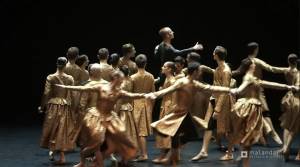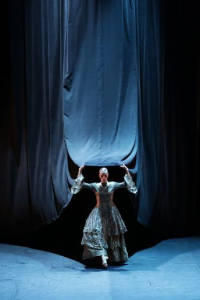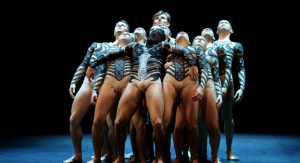Beauty, the Beast, the Artist, Body, Soul, Curtains: Showy Ballet Lacks Heart
When Malandain Ballet Biarritz made its first San Diego appearance two years ago, the company’s costumes and sets were stuck on a ship in the Atlantic. So, instead of a planned evening-length ballet, artistic director/choreographer Thierry Malandain cobbled together a terrific program of shorter works with bought-at-the-last-minute costumes and Home Depot props. (I titled my review “Malandain Ballet Gets Lemons and Makes Lemon Mousse.”)

The black-clad Artist and the Malandain corps
The French company returned on Saturday, presented again by La Jolla Music Society at the Civic Theatre. This time, everything arrived successfully, and we got Malandain’s “Beauty and the Beast,” with inventive sets and splendid Louis XIV-era costumes, including bell-skirted dresses for the women in the corps and frock coats for the men, all in a lovely muted gold. (The costumes and sets were by Jorge Gallardo).
It was a pleasure to get another look at these phenomenal dancers, masters of the European contemporary style that marries the fluid grace of classical ballet with an earthy muscularity. And here, as before, I enjoyed seeing Malandain sometimes echo and sometimes wittily play against the mood of his well-chosen score, excerpts from Tchaikovsky symphonic works. Ultimately, though, “Beauty and the Beast” was less satisfying than the troupe’s previous jury-rigged program.
 The set, in fact, was part of the problem. Malandain sees Beauty and the Beast as representing our divine and animal natures. The major set element—several full-stage curtains, hung at different depths and able to be fully open, closed, or in between—seems a fitting metaphor for hidden aspects of the self, and Malandain builds a great deal of choreography around them. Dancers lie under the curtains so we see just part of their bodies—there’s a wonderful bit where the corps’ thrashing legs suggest a storm at sea. Dancers roll up in curtains and vanish. All of this felt clever and fresh at first. And then I began to long for the emotion this classic tale should convey.
The set, in fact, was part of the problem. Malandain sees Beauty and the Beast as representing our divine and animal natures. The major set element—several full-stage curtains, hung at different depths and able to be fully open, closed, or in between—seems a fitting metaphor for hidden aspects of the self, and Malandain builds a great deal of choreography around them. Dancers lie under the curtains so we see just part of their bodies—there’s a wonderful bit where the corps’ thrashing legs suggest a storm at sea. Dancers roll up in curtains and vanish. All of this felt clever and fresh at first. And then I began to long for the emotion this classic tale should convey.
But the story has to compete with more than just the curtain business. Malandain also uses a framing device in which three dancers in black practice clothes represent the Artist, the Body, and the Soul. The Artist, Arnaud Mahouy, is a particularly strong presence, and, by giving the trio significant time center-stage, Malandain drives home his conceptual point. But what about the title characters? And the story’s heart?

The featureless Beast with the corps
Beauty and the Beast do appear. And Mickaël Conte’s Beast is striking, doing deeply contorted, insectlike moves, a black stocking over his head rendering him creepily featureless. As Beauty, however, Claire Lonchampt is largely limited to taking delicate little steps, embracing her papa, and cowering from the Beast. Her greedy sisters (Ione Aguirre and Mathilde Labé) get the juicy choreography, a fantastic signature style of right-angled elbows and clenched-fist “me me” gestures.
What I missed the most was the tender process by which Beauty becomes aware of the Beast’s inherent goodness. Although Malandain was inspired by Jean Cocteau’s iconic film “La Belle et la Bête,” the magic got lost in this translation to dance.

Award-winning dance journalist Janice Steinberg has published more than 400 articles in the San Diego Union-Tribune, Dance Magazine, the Los Angeles Times, and elsewhere. She was a 2004 New York Times-National Endowment for the Arts fellow at the Institute for Dance Criticism and has taught dance criticism at San Diego State University. She is also a novelist, author of The Tin Horse (Random House, 2013). For why she’s passionate about dance, see this article on her web site, The Tin Horse
